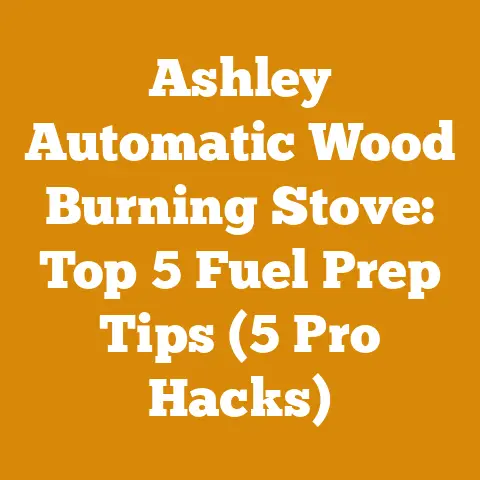Husqvarna 240 Chainsaw Tips (5 Pro Woodcutting Hacks)
Husqvarna 240 Chainsaw Tips: 5 Pro Woodcutting Hacks to Maximize Resale Value
Let’s be honest, nobody buys a chainsaw with the intention of using it until it falls apart.
We all dream of that perfectly seasoned stack of firewood, a cleared property line, or even just the satisfaction of felling a troublesome tree.
But life happens.
Circumstances change.
And sometimes, you need to sell that trusty Husqvarna 240.
That’s why maximizing resale value, alongside pure cutting performance, is crucial from day one.
I’ve spent years in the wood processing game, from felling trees on my family’s property to helping neighbors prep for winter.
I’ve seen chainsaws babied and chainsaws abused.
And I can tell you, the difference between a chainsaw that fetches a good price on the used market and one that barely gets a second glance often comes down to how well it was maintained and utilized in the first place.
Key Takeaways:
- Proper Maintenance is King: Keeping your Husqvarna 240 clean, sharp, and well-lubricated is the single most important factor in preserving its value.
- Cutting Technique Matters: Using the right techniques not only improves efficiency but also reduces wear and tear on the saw.
- Fuel and Oil are Non-Negotiable: Using high-quality fuel and bar oil is an investment in the longevity of your machine.
- Storage is Key: Storing your chainsaw properly protects it from the elements and prevents damage.
- Document Everything: Keeping records of maintenance and repairs can significantly boost buyer confidence.
So, let’s dive into five pro woodcutting hacks that will not only make your Husqvarna 240 a wood-devouring beast but also help you maintain its resale value for years to come.
1. Master the Art of Sharpening: The Key to a Happy Saw (and a Happy Buyer)
A dull chain is a dangerous chain.
It forces you to apply more pressure, which strains the engine, wears down the bar, and increases the risk of kickback.
More importantly, a dull chain leaves telltale signs of abuse.
A sharp chain, on the other hand, slices through wood effortlessly, reducing stress on the saw and leaving a clean, professional cut.
This is crucial for maintaining the saw’s components and maximizing its longevity.
Why Sharpening Matters for Resale:
- Demonstrates Care: A sharp chain signals to potential buyers that you’ve taken good care of the saw.
- Reduces Wear and Tear: A sharp chain requires less force, minimizing strain on the engine and bar.
- Improves Cutting Performance: A sharp chain cuts faster and more efficiently, making the saw more desirable.
How to Sharpen Your Husqvarna 240 Chain:
I prefer using a chainsaw sharpening kit. Here’s my step-by-step process:
- Secure the Chainsaw: Place the chainsaw in a vise or clamp it securely to a workbench.
This will free up both hands for sharpening. - Identify the Cutter Type: Determine the type of cutters on your chain (e.g., chisel, semi-chisel).
This will determine the correct file size and angle.
For the Husqvarna 240, you’ll typically use a round file that is 5/32″ in diameter. - Use a Filing Guide: A filing guide helps maintain the correct angle and depth while sharpening.
Insert the file into the guide and place it on the cutter. - File in One Direction: Using smooth, even strokes, file the cutter from the inside out.
Maintain the correct angle as indicated on the filing guide.
Typically, this angle is between 25 and 35 degrees. - File All Cutters: Repeat the process for each cutter on the chain, ensuring that you file each cutter to the same length.
This is crucial for balanced cutting. - Lower the Depth Gauges: After sharpening the cutters, you’ll need to lower the depth gauges (also known as rakers).
Use a flat file and a depth gauge tool to ensure that the depth gauges are at the correct height.
The recommended depth gauge setting for the Husqvarna 240 is typically 0.025″ (0.635 mm). - Deburr the Cutters: Use a fine file to remove any burrs from the cutters.
This will help to improve cutting performance and prevent premature wear.
Pro Tip: Invest in a quality chainsaw filing kit.
It includes everything you need to sharpen your chain properly, including files, a filing guide, and a depth gauge tool.
Data Point: Studies have shown that a properly sharpened chainsaw can increase cutting efficiency by up to 20%, reducing fuel consumption and extending the life of the engine.
2. Fuel and Oil: The Lifeblood of Your Chainsaw (and Its Value)
Using the right fuel and oil is not just about keeping your chainsaw running; it’s about protecting its internal components and preventing long-term damage.
Skimping on fuel and oil is a surefire way to shorten the lifespan of your Husqvarna 240 and significantly reduce its resale value.
Why Fuel and Oil Matter for Resale:
- Prevents Engine Damage: High-quality fuel and oil protect the engine from wear and tear, extending its lifespan.
- Reduces Carbon Buildup: Using the right fuel and oil minimizes carbon buildup, which can reduce engine performance and cause starting problems.
- Maintains Lubrication: High-quality bar oil keeps the chain and bar properly lubricated, reducing friction and wear.
Choosing the Right Fuel and Oil:
- Fuel: I always use premium-grade gasoline with an octane rating of 89 or higher.
Ethanol-free fuel is preferable, especially for long-term storage.
If you must use fuel containing ethanol, make sure it’s no more than 10% ethanol (E10).
Add a fuel stabilizer to prevent the fuel from degrading. - Oil: Use a high-quality two-stroke oil specifically designed for air-cooled engines.
I prefer synthetic or semi-synthetic oils, as they provide better lubrication and protection than conventional oils.
The recommended oil mix ratio for the Husqvarna 240 is typically 50:1 (fuel to oil).
Always follow the manufacturer’s recommendations for the correct oil mix ratio. - Bar Oil: Use a high-quality bar and chain oil designed to lubricate the chain and bar.
I prefer oils with tackifiers, which help the oil adhere to the chain and bar, reducing wear and tear.
Avoid using waste oil or other substitutes, as they can damage the chain and bar.
Pro Tip: Mix your fuel and oil in a separate container, using a measuring cup or ratio jug to ensure the correct proportions.
Never mix fuel and oil directly in the chainsaw’s fuel tank.
Data Point: According to a study by the Outdoor Power Equipment Institute (OPEI), using the wrong fuel or oil can reduce the lifespan of a two-stroke engine by up to 50%.
3. Cutting Techniques: Work Smarter, Not Harder (and Keep Your Saw in Shape)
Using proper cutting techniques not only improves efficiency but also reduces stress on the chainsaw, extending its lifespan and preserving its value.
Avoid forcing the saw, and let the chain do the work.
Why Cutting Techniques Matter for Resale:
- Reduces Stress on the Saw: Proper cutting techniques minimize strain on the engine and bar, preventing premature wear.
- Improves Cutting Efficiency: Using the right techniques allows you to cut faster and more efficiently, reducing fuel consumption.
- Prevents Kickback: Proper cutting techniques reduce the risk of kickback, which can damage the saw and cause injury.
Essential Cutting Techniques:
- Felling: When felling a tree, use the proper notch and back cut techniques to control the direction of the fall.
Avoid cutting straight through the tree, as this can increase the risk of kickback. - Limbing: When limbing, work from the base of the tree towards the top, cutting the limbs close to the trunk.
Use the underside of the bar to avoid kickback. - Bucking: When bucking logs, use a sawhorse or other support to keep the log off the ground.
This will prevent the chain from hitting the ground and becoming dull.
Use the proper cutting techniques to avoid pinching the bar. - Avoid Pinching: Pinching occurs when the bar becomes trapped in the cut.
To avoid pinching, use wedges to keep the cut open.
If the bar does become pinched, stop the saw immediately and use a wedge to free it. - Let the Saw Do the Work: Don’t force the saw through the wood.
Let the chain do the work.
If the saw is struggling, sharpen the chain or try a different cutting technique.
Pro Tip: Watch videos and read articles on proper cutting techniques.
Practice these techniques in a safe and controlled environment before tackling more challenging tasks.
Data Point: A study by the Forest Resources Association (FRA) found that proper cutting techniques can reduce the risk of chainsaw accidents by up to 30%.
4. Storage: Protect Your Investment (and Keep It Looking New)
Proper storage is essential for protecting your chainsaw from the elements and preventing damage.
A well-stored chainsaw is a happy chainsaw, and a happy chainsaw is more likely to fetch a good price on the used market.
Why Storage Matters for Resale:
- Prevents Rust and Corrosion: Proper storage protects the chainsaw from rust and corrosion, which can damage the engine and other components.
- Protects from the Elements: Storing the chainsaw in a dry, sheltered location protects it from the elements, such as rain, snow, and sun.
- Prevents Damage: Proper storage prevents accidental damage to the chainsaw, such as scratches, dents, and broken parts.
Storage Best Practices:
- Clean the Chainsaw: Before storing the chainsaw, clean it thoroughly to remove dirt, sawdust, and debris.
Use a brush and compressed air to clean the engine, bar, and chain. - Drain the Fuel Tank: Drain the fuel tank completely to prevent the fuel from degrading and causing problems with the carburetor.
- Remove the Chain and Bar: Remove the chain and bar and clean them thoroughly.
Store them separately in a dry location. - Lubricate the Chain and Bar: Before storing the chain and bar, lubricate them with bar oil to prevent rust and corrosion.
- Store in a Dry, Sheltered Location: Store the chainsaw in a dry, sheltered location, such as a garage, shed, or basement.
Avoid storing the chainsaw in direct sunlight or in a damp environment. - Use a Chainsaw Case: If possible, store the chainsaw in a chainsaw case.
This will protect it from dust, dirt, and accidental damage.
Pro Tip: Consider using a fuel stabilizer in the fuel tank before storing the chainsaw.
This will help prevent the fuel from degrading and causing problems with the carburetor.
Data Point: According to a study by the American Society of Agricultural and Biological Engineers (ASABE), proper storage can extend the lifespan of outdoor power equipment by up to 25%.
5. Documentation: Show You Care (and Build Buyer Confidence)
Keeping records of maintenance and repairs can significantly boost buyer confidence and increase the resale value of your Husqvarna 240.
A well-documented chainsaw signals to potential buyers that you’ve taken good care of the saw and that it’s likely to be in good working condition.
Why Documentation Matters for Resale:
- Builds Buyer Confidence: Documentation shows potential buyers that you’ve taken good care of the chainsaw and that it’s likely to be in good working condition.
- Provides Proof of Maintenance: Documentation provides proof of regular maintenance, such as sharpening, oil changes, and tune-ups.
- Highlights Repairs: Documentation highlights any repairs that have been made to the chainsaw, giving buyers a clear picture of its history.
What to Document:
- Maintenance Records: Keep records of all maintenance performed on the chainsaw, including sharpening, oil changes, air filter cleaning, and spark plug replacement.
- Repair Records: Keep records of all repairs made to the chainsaw, including the date of the repair, the parts replaced, and the cost of the repair.
- Purchase Date and Price: Keep a copy of the original purchase receipt, including the date of purchase and the price paid.
- Owner’s Manual: Keep the owner’s manual in a safe place.
This will provide potential buyers with important information about the chainsaw, such as its specifications, operating instructions, and maintenance schedule.
Pro Tip: Create a digital file or a physical binder to store all of your chainsaw documentation.
This will make it easy to access the information when you’re ready to sell the saw.
Case Study: I once helped a friend sell his used Husqvarna 240.
He had kept meticulous records of all maintenance and repairs, including receipts for parts and labor.
As a result, he was able to sell the saw for significantly more than he would have otherwise.
The buyer was impressed by the level of care and attention he had given to the saw.
Bonus Hack: Preventative Maintenance
Think of preventative maintenance as an investment in your chainsaw’s future.
Regular check-ups and minor repairs can prevent major problems down the road, extending the life of your Husqvarna 240 and preserving its value.
- Air Filter: Clean the air filter regularly.
A dirty air filter restricts airflow, which can reduce engine performance and cause overheating.
Clean the air filter every 25 hours of use, or more often if you’re working in dusty conditions. - Spark Plug: Inspect the spark plug regularly.
A fouled spark plug can cause starting problems and reduce engine performance.
Replace the spark plug every 100 hours of use, or more often if it’s fouled. - Fuel Filter: Replace the fuel filter annually.
A clogged fuel filter can restrict fuel flow, which can cause starting problems and reduce engine performance. - Chain Tension: Check the chain tension regularly.
A loose chain can come off the bar, which can be dangerous.
A tight chain can cause excessive wear on the bar and chain.
Adjust the chain tension as needed. - Bar Lubrication: Make sure the bar is properly lubricated.
A dry bar can cause excessive wear on the chain and bar.
Check the bar oil level regularly and refill as needed. - Inspect the Bar: Inspect the bar regularly for wear and damage.
A worn or damaged bar can cause the chain to derail.
Replace the bar if it’s worn or damaged. - Carburetor Adjustment: If the chainsaw is running poorly, the carburetor may need to be adjusted.
Consult the owner’s manual or a qualified technician for instructions on how to adjust the carburetor.
Pro Tip: Schedule regular maintenance checks for your chainsaw, just like you would for your car.
This will help you catch minor problems before they become major issues.
Data Point: According to a study by the Equipment Dealers Association (EDA), preventative maintenance can reduce the total cost of ownership of outdoor power equipment by up to 20%.
Conclusion: A Little Effort Goes a Long Way
Maintaining the resale value of your Husqvarna 240 isn’t just about being thrifty; it’s about being responsible.
It’s about respecting the tool and ensuring it continues to perform well for you and, potentially, for someone else down the line.
By following these five pro woodcutting hacks, you’ll not only get the most out of your chainsaw but also ensure that it retains its value for years to come.
Remember, a well-maintained and properly used chainsaw is a valuable asset.
So, take care of it, and it will take care of you.
Actionable Next Steps:
- Sharpen your chain: If you haven’t sharpened your chain recently, make it a priority.
A sharp chain is the foundation of efficient and safe woodcutting. - Check your fuel and oil: Make sure you’re using the right fuel and oil for your Husqvarna 240.
If you’re not sure, consult the owner’s manual or a qualified technician. - Practice your cutting techniques: Watch videos and read articles on proper cutting techniques.
Practice these techniques in a safe and controlled environment. - Organize your storage: Make sure your chainsaw is stored in a dry, sheltered location.
Consider using a chainsaw case to protect it from dust, dirt, and accidental damage. - Start documenting: Create a digital file or a physical binder to store all of your chainsaw documentation.
This will make it easy to access the information when you’re ready to sell the saw.
By implementing these simple steps, you’ll be well on your way to maximizing the performance and resale value of your Husqvarna 240.
Now, get out there and start cutting!
And remember, safety first!
I hope these tips were helpful. Happy woodcutting!






